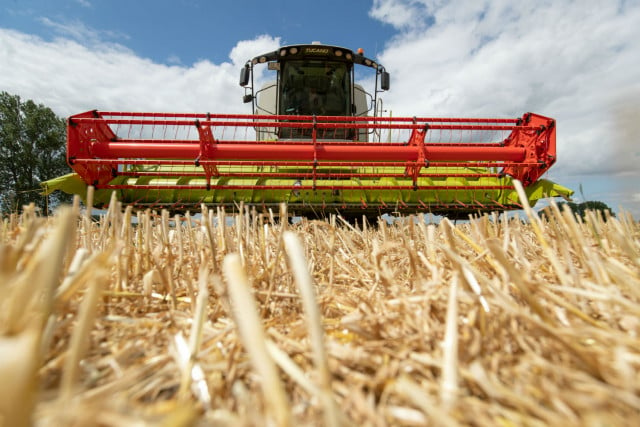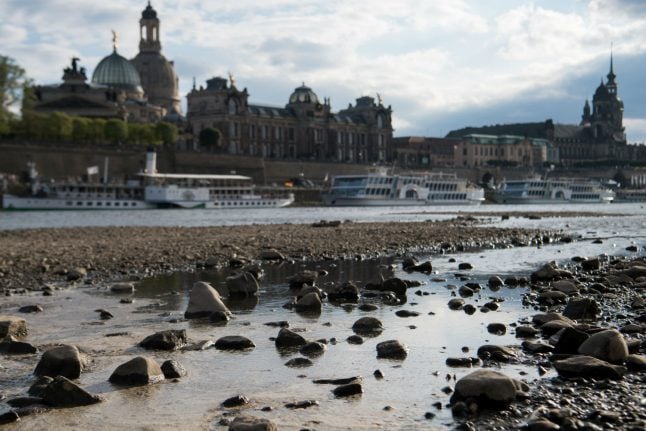Turn on the tap – and nothing comes out? Around Germany most people know this only from burst pipes or repair work. But in the second dry summer in a row – and following record-breaking temperatures in June – regions like Lusatia in the eastern German state Brandenburg face a problem: If it continues to rain so little, water supplies could become scarce.
This is completely new for Germany, which has led authorities to look to places like California and China which have been grappling with drought for a long time.
“So far, water stress has not been a relevant issue for us,” says Jörg Rechenberg, a water expert at the Federal Environment Agency (UBA).
“The noticeably prolonged drought in the summer of 2018 makes not only scientists and authorities, but also the general public, aware that water scarcity is a problem or can at least become one. Distribution disputes, for example between water suppliers and agriculture, are already foreseeable.”
The situation cannot be overlooked: the Elbe and Oder rivers running through eastern Germany carried so little water, even before the start of summer, that sandbanks and rocks were left exposed.
In the middle of Magdeburg, ships could no longer moor at the beginning of July; in Dresden, freight traffic on the water was no longer possible as the Elbe River lost 50 centimetres of water in three days.
'Lakes and ponds are drying up'
Drought is also posing a problem for nearby agriculture. The local cooperative Heideglück Sprotta reported a 50 percent loss of corn due to “fields as dry as the desert,” farmer Karsten Ittner told BILD.
“We can't even plow because the surrounding villages would sink under clouds of dust,” he added.
Dr Andreas Marx of the Central German Climate Office feels there's little hope for improvement in the region.
“The soil has already dried up to two metres deep,” he said. “The drought of 2018 never stopped due to low precipitation in winter and spring. The need is highly dramatic in the forests, where the most aggressive tree pests are eating their way through. Even lakes and ponds are drying up.”
According to the Brandenburg Ministry of the Environment, the storage facilities in Lusatia normally hold 88 million cubic metres of water reserves. But now there are only 58 million left.
Consequently, in Cottbus farmers and garden owners are not allowed to pump water from rivers, lakes or ditches between 6 am and 9 pm on Sunday.
In Lower Saxony, the drought has also become a big issue: in 2018, farmers experienced a 22 percent loss in agriculture, according to DPA, and are not expecting better results this year.

A dry field at the beginning of July in Bohmte, Lower Saxony. Photo: DPA
Cottbus becoming California?
This means that the scarcity situation in Lusatia no longer looks so different than that of the US state of California, which has been afflicted again and again by dry periods, some lasting several years.
The authorities reacted not only with appeals to cut down on water use, but also through legal limitations and penalties for overuse.
In some districts, residents were only allowed to water their gardens twice a week for 15 minutes. Anyone who caught so-called “water sinners” under California law could report them to the authorities in the state capital of Sacramento.
The effect: in many places lawns disappeared and only low water-intensive crops were planted.
Yet the Germany Environment Agency does not yet want to talk about water stress throughout the country, said Rechenberg. Germany, as a whole, has a freshwater resource of 188 billion cubic metres.
Compared to Southern Europe, it is rich in groundwater and surface water. So far, Germany has only taken around 13 percent per year from this supply. The situation would only be considered a scarcity if more than 20 percent of the water were withdrawn.
Cutting back on personal use
Regionally, however, this may look different. In some places, water suppliers are concerned about drinking water reserves.
Lawn sprinklers consume up to 800 litres of water per hour, says Karsten Specht, Vice President of the Association of Municipal Enterprises. That's about seven times as much as every German citizen consumes from the tap every day.
Rechenberg is already thinking about possible savings scenarios. “We don't want to cut back on hygiene,” he emphasized, adding that taking a shower is still better than taking a full bath.
“Most people have already installed economy fittings anyway, for example for low-flush toilets,” he said.
Private pools, although not widespread in Germany, will “certainly be the first thing on the scratch list,” he added.
Thinking about set irrigation times in the garden is advisable, said Rechenberg.
It’s best in the evening and very early in the morning – and not in the blazing midday heat when too much water evaporates. “You also have to be more focused on the plants. Automatic systems have the potential to work precisely and with timers. This saves water.”
Nobody in Germany is yet expecting a shortage of drinking water, but if there is a long enough drought, agriculture could have to rethink its approach.
“In order not to rely solely on surface water and groundwater, the recycling of process water for agriculture will have to be considered,” said Rechenberg.
Vocab
Drought – Die Dürre
Agriculture – Die Landwirtschaft
Water tap – Der Wasserhahn
Water resources – Die Wasservorräte



 Please whitelist us to continue reading.
Please whitelist us to continue reading.
Member comments